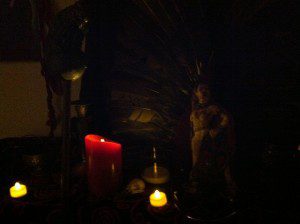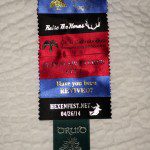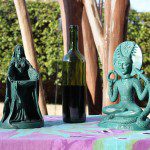
Some of the Pantheacon hospitality suites included small altars or shrines, similar to the installations many Pagans have in our homes. But one stood out – the Temple of the Morrigan, built and maintained by the Coru Cathubodua. It was the site of the most powerful experience of my time at the convention, and I hope it will inspire others to create temples at Pagan events around the world.
Structure of the Temple
Some sacred things should be photographed and some shouldn’t. I didn’t even ask to take pictures in this temple – no photograph could accurately represent the experience of being there.
Imagine a hotel room with the beds removed and all mundane objects covered. The curtains were closed and there was a black cloth separating the entryway and bathroom from the main room. There was a low stool holding a bowl of water for cleansing and a place to leave your shoes.
Around the walls were five altars. The main altar was to the Morrigan in all Her forms. I have experienced Her as one deity and so that’s how I write and speak of Her, but the lore is far more complex. The altar contained representations of ravens, but there was also a decorated horse skull representing Macha.
The other four altars were centered around the Four Treasures of the Tuatha De Danann and the cities from which they were brought to Ireland. From the city of Murias came the Cauldron of the Dagda, from which no one ever went away unfilled. This altar was dedicated to the Dagda (who with the aid of Morrigan defeated the Fomorians), to his daughter Brighid, and to Goibniu the Smith.
From the city of Falias came the Lia Fail, the stone which would cry out in the presence of the true King of Ireland. This altar held a bowl of soil and was dedicated to Eiru Goddess of the Land, and to the Ancestors.
From the city of Findias came the Sword of Nuada. No one could resist it or escape it once it was drawn. This altar held numerous swords, representing both war counsel and diplomacy. It was dedicated to Nuada and to Scathach, the warrior woman who trained the great hero Cu Chulainn (who often tangled with the Morrigan, though exactly why has been a point of contention).
From the city of Gorias came the Spear of Lugh. No battle ever went against it or the warrior who held it. This altar was dedicated to Lugh the Master of All Arts, to Cu Chulainn, and to Fionn mac Cumhaill, leader of the mighty Fianna.
On each altar was an offering bowl. The Coru felt that mixing offerings made for an unpalatable drink (you wouldn’t want to drink a mixture of mead, whiskey and ale – why would you think the Gods would want it?), so they provided a bottle from which to pour offerings on each altar. Donations were placed into service throughout the weekend.
The setup was beautiful and elegant, but the physical construction was only one part of the temple.
Opening Ritual
Have you ever been to a ritual or had a spontaneous religious experience where you’re not quite sure what just happened, but you know it was strong and important and real? This was like that.
At each altar, one of the priests of the Coru invoked the honorees of that altar and made an offering. In addition to being a place of honor and a place of sacrifice, each altar was also a gateway to the city from which its Treasure had been brought – cities that now exist only in the Otherworld. These gateways were ritually opened.
As Morpheus Ravenna invoked the Morrigan at the main altar, a half-filled cup was passed around the room. Each participant (I didn’t count – I think there were about 15 of us) breathed our prayers into it, and at the appropriate time it was poured into the offering bowl. It wasn’t just one person performing the invocation – it was all of us.
The liturgy was simple and directed outward. It wasn’t about making the participants feel or experience anything – though I certainly did. It was about passionately inviting and welcoming Gods, heroes, and ancestors to this temple and to this gathering.
Daily Activities
For practical reasons, the hotel room containing the temple was locked when the Coru priests were sleeping or away at ritual. But during the normal course of the convention it was open for meditation, prayer, and offerings. I visited for a short while each day – the temple was a quiet, contemplative sanctuary in the middle of all the loud and boisterous events and activities.
And They were there. I’ve never had trouble hearing deities, but Their presence in the temple was especially clear and real and almost tangible. Others spoke of the crossroads of energies formed by the four gates. It was a place and time for communion – for speaking to Them and for listening for Their responses.
Overall Impressions
The Temple of the Morrigan was an experience that couldn’t be found anywhere else at Pantheacon – not in rituals, not in workshops, not even next door talking with the Coru priests. Several participants said something along the lines of “I wish other groups would do this.” Some traditions already have guidelines and rubrics for temples – it would be good to see and experience them. Other traditions – particularly the newer Pagan traditions – have grown up in living rooms and back yards and public parks. For those traditions, a temple at a gathering would be a chance to experiment with both structures and liturgies, to see what works well and what sounds good but really isn’t.
Because some day we will have permanent temples.
My gratitude to the Coru Cathubodua for their hard work in setting up the Temple of the Morrigan and for their hospitality. Keeping the temple open meant someone had to be there all day (and not off playing at the con): answering questions, emptying offering bowls (there’s a tree beside the Doubletree hotel that should be feeling really really good for quite some time!) and making sure fresh bottles were available when needed.
And my highest gratitude to the Gods, heroes and ancestors who filled the temple with their presence and who were there for me and for so many others.
Thank you all.
For another, more intimate account of the Temple, see this post by Morpheus Ravenna
















